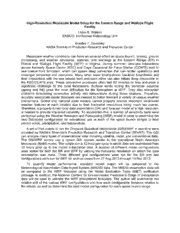
NASA Technical Reports Server (NTRS) 20150002902: High-Resolution Mesoscale Model Setup for the Eastern Range and Wallops Flight Facility PDF
Preview NASA Technical Reports Server (NTRS) 20150002902: High-Resolution Mesoscale Model Setup for the Eastern Range and Wallops Flight Facility
High-Resolution Mesoscale Model Setup for the Eastern Range and Wallops Flight Facility Leela R. Watson ENSCO, Inc/Applied Meteorology Unit Bradley T. Zavodsky NASA Short-term Prediction Research and Transition Center Mesoscale weather conditions can have an adverse effect on space launch, landing, ground processing, and weather advisories, watches, and warnings at the Eastern Range (ER) in Florida and Wallops Flight Facility (WFF) in Virginia. During summer, land-sea interactions across Kennedy Space Center (KSC) and Cape Canaveral Air Force Station (CCAFS) lead to sea breeze front formation, which can spawn deep convection that can hinder operations and endanger personnel and resources. Many other weak locally-driven low-level boundaries and their interactions with the sea breeze front and each other can also initiate deep convection in the KSC/CCAFS area. These convective processes often last 60 minutes or less and pose a significant challenge to the local forecasters. Surface winds during the transition seasons (spring and fall) pose the most difficulties for the forecasters at WFF. They also encounter problems forecasting convective activity and temperature during those seasons. Therefore, accurate mesoscale model forecasts are needed to better forecast a variety of unique weather phenomena. Global and national scale models cannot properly resolve important local-scale weather features at each location due to their horizontal resolutions being much too coarse. Therefore, a properly tuned local data assimilation (DA) and forecast model at a high resolution is needed to provide improved capability. To accomplish this, a number of sensitivity tests were performed using the Weather Research and Forecasting (WRF) model in order to determine the best DA/model configuration for operational use at each of the space launch ranges to best predict winds, precipitation, and temperature. A set of Perl scripts to run the Gridpoint Statistical Interpolation (GSI)/WRF in real-time were provided by NASA’s Short-term Prediction Research and Transition Center (SPoRT). The GSI can analyze many types of observational data including satellite, radar, and conventional data. The GSI/WRF scripts use a cycled GSI system similar to the operational North American Mesoscale (NAM) model. The scripts run a 12-hour pre-cycle in which data are assimilated from 12 hours prior up to the model initialization time. A number of different model configurations were tested for both the ER and WFF by varying the horizontal resolution on which the data assimilation was done. Three different grid configurations were run for the ER and two configurations were run for WFF for archive cases from 27 Aug 2013 through 10 Nov 2013. To quantify model performance, standard model output will be compared to the Meteorological Assimilation Data Ingest System (MADIS) data. The MADIS observation data will be compared to the WRF forecasts using the Model Evaluation Tools (MET) verification package. In addition, the National Centers for Environmental Prediction’s Stage IV precipitation data will be used to validate the WRF precipitation forecasts. The author will summarize the relative skill of the various WRF configurations and how each configuration behaves relative to the others, as well as determine the best model configuration for each space launch range.
